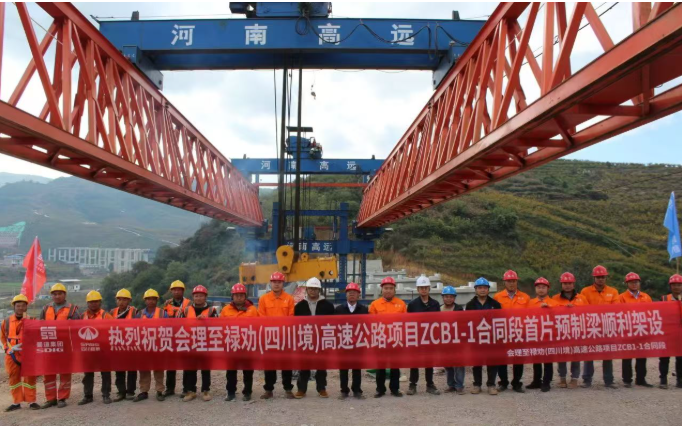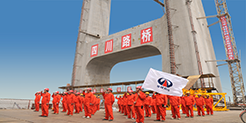- About
- News
-
Business
-
Engineering Construction
Committed to excellence in engineering construction and project execution. -
Mining And New Materials
Integrating mining operations with the development of cutting-edge new materials. -
Clean Energy
Committed to the development of clean energy solutions for a sustainable future.

-
-
Technological
-
Major Awards
Honored with major awards that reflect our excellence and leadership in the industry. -
Research And Development Platform
Equipped with a state-of-the-art research and development platform to support cutting-edge solutions. -
Science And Technology Achievements
Showcasing our breakthroughs and applied technological accomplishments in infrastructure development. -
Innovation Dynamics
Stay updated on our latest innovations and technological advancements.

-
- Brand
- Human Resources
-
Social Responsibility
-
Rescue And Disaster Relief
Committed to emergency rescue and disaster relief with swift and effective response capabilities. -
Poverty Alleviation/Rural Revitalization
Committed to poverty alleviation and rural revitalization for sustainable community development. -
Social Welfare(Donate To Support Education)
Committed to social welfare through philanthropic efforts, including educational funding and support. -
Sustainable Report
Our Sustainability Report details our commitment to environmental stewardship, social responsibility, and sustainable growth.

-
-
Investors Relation
-
Stock Price Situation
Overview of our stock performance and market trends. -
Temporary Notice
Timely announcements and urgent notices to keep stakeholders informed. -
Regular Report
Regular reports providing insights into our financial performance and business operations. -
Dividend Distribution Situation
Information on dividend distribution and shareholder returns. -
Investor Hotline
Dedicated investor hotline providing timely support and information.

-
After 60 days of intense work, the final battle was won | The first T-beam of the ZCB1-1 project on Huilu Expressway was successfully erected
Pubdate :2025-05-22
At 10 a.m. on November 25th, the first T-beam of the ZCB1-1 project on the Huilu Expressway was successfully erected, marking that the project has entered a new stage of bridge superstructure construction and taking a solid step towards the annual target tasks in the overall construction.

The project ensured the successful erection of the first T-beam from multiple aspects. Firstly, it carefully studied and formulated the erection plan, detailed the task breakdown, and arranged dedicated personnel to conduct detailed safety and technical briefings and pre-job training for technical management personnel and beam erection construction teams, enabling the operation personnel to fully master the key points and precautions during the transportation and erection of T-beams. Second, strictly manage the safety of the erection site. Before erection, carefully inspect the equipment, implement on-site traffic control in advance, and check the wearing of safety protective equipment by the operators to ensure the safe and smooth completion of all operations during the beam erection process. Third, quality control during the erection process was strictly implemented. Before erection, the test personnel inspected the appearance, dimensions, and embedded parts of the T-beams to ensure that all data met the specification requirements. After erection, they promptly checked and adjusted the erection accuracy to ensure that all data such as axis deviation and top height were qualified.

The Gujiawan No. 1 Bridge is designed to have 60 T-beams. So far, 14 of them have been prefabricated and it is expected that the remaining T-beams will be erected by mid-December. The successful erection of the first T-beam is a vivid demonstration of the project's response to the call of "working hard for 60 days to win the final battle", laying a solid foundation for the subsequent construction of the bridge deck system and the formation of longitudinal passages, and is of great significance for promoting the overall construction goals of the project. Taking this as an opportunity, the project will continue to redouble its efforts, forge ahead bravely, and constantly create a construction upsurge of "working hard and fast, learning from each other and catching up with each other". With a decisive and victorious attitude, it will strive to achieve the annual target tasks.
Extended reading
The Gujiawan No. 1 Bridge being erected this time is the closest to the smart beam yard of the project. The project is a mountainous expressway with a bridge and tunnel ratio of 70%. Adhering to the concept of environmental protection first and cost savings, after thorough communication with the design team, the construction of the smart beam yard adopts a permanent and temporary combination approach. The hardened layer of the beam yard is used as the pavement cushion and base layer.

The "Smart Beam Yard" mainly realizes intelligent production of beams and slabs from four aspects:
First, in terms of production, the prefabrication production line adopts an assembled mobile base and an integrated hydraulic transverse moving combined steel formwork, upgrading the conventional process to a "circulating base within the site and automatic disassembly and assembly of formwork" assembly line. This eliminates problems such as leakage caused by incorrect formwork assembly, enhances production efficiency, and reduces safety risks.
Second, in terms of transfer, a bottom mold walking control system is adopted to achieve the longitudinal movement of the production line trolley, and it is equipped with functions such as fast and slow speed switching, emergency stop, and alarm indication. All operations are carried out by wireless remote control, avoiding the time required for the hoisting and storage of conventional gantry cranes.
Thirdly, in terms of curing, an intelligent steam curing system is adopted to shorten the curing time of concrete. Automatic sprinkling is achieved through sensors to ensure the quality of curing. An intelligent tensioning and grouting system is used to ensure that the quality of the entire tensioning and grouting process is controllable.
Fourth, in terms of information management, an intelligent beam yard information management system is installed to monitor the production process through the Internet of Things and integrate it in series. This enables real-time understanding of the production situation, perception of equipment, quality, environment and other information, so that managers can make reasonable decisions in a timely manner and ensure the quality and progress of prefabricated beam and slab construction.





